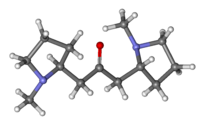Cuscohygrine
 |
|
 |
|
| Names | |
|---|---|
|
IUPAC name
1-[(2R)-1-Methyl-2-pyrrolidinyl]-3-[(2S)-1-methyl-2-pyrrolidinyl]acetone
|
|
| Identifiers | |
| 454-14-8 | |
| 3D model (Jmol) | Interactive image |
| ChemSpider | 21864896 |
| KEGG | C06521 |
|
|
|
|
| Properties | |
| C13H24N2O | |
| Molar mass | 224.35 g·mol−1 |
| Melting point | 40–41 °C (104–106 °F; 313–314 K) (trihydrate) |
|
Except where otherwise noted, data are given for materials in their standard state (at 25 °C [77 °F], 100 kPa).
|
|
| Infobox references | |
Cuscohygrine is a pyrrolidine alkaloid found in coca. It can also be extracted from plants of the family Solanaceae as well, including Atropa belladonna (deadly nightshade), Datura inoxia and Datura stramonium (jimson weed). Cuscohygrine usually occurs along with other, more potent alkaloids such as atropine or cocaine.
Cuscohygrine, along with the related metabolite hygrine, was first isolated by Carl Liebermann in 1889 as an alkaloid accompanying cocaine in coca leaves (also known as Cusco-leaves).
Cuscohygrine is an oil that can be distilled without decomposition only in vacuum. It is soluble in water. It also forms a crystalline trihydrate which melts at 40–41 °C.
...
Wikipedia
